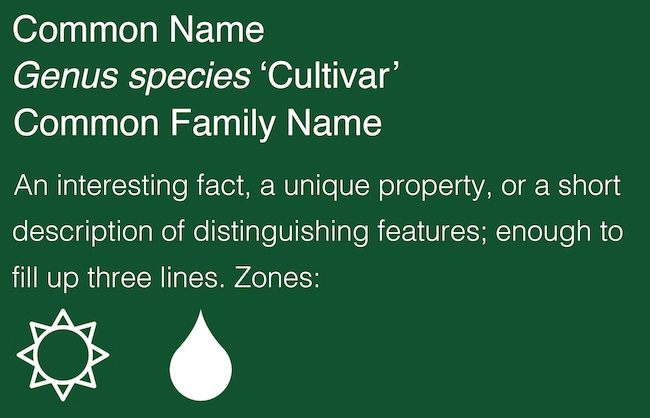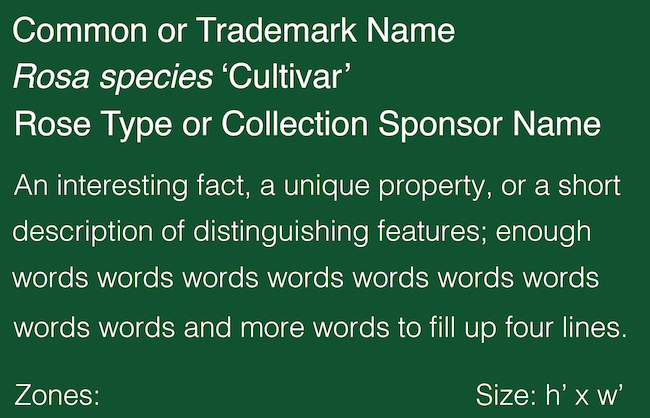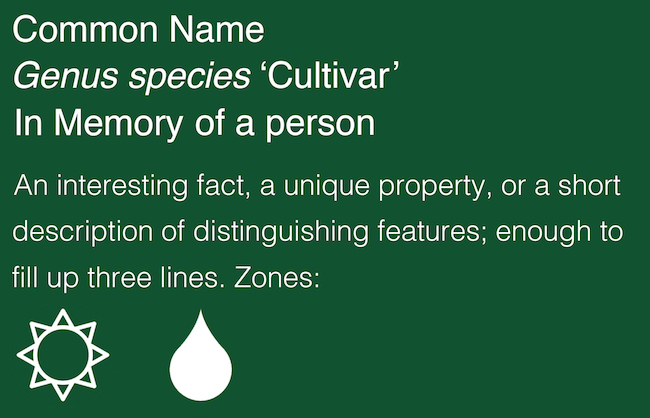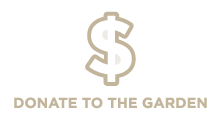Here's Your Sign
Submitted February 27, 2019 at 12:00 PM
As you walk through the Garden, you can not help but notice the teal-colored identification labels that we carefully place in front of, or within, our plants. In this blog post, we're going to break down the format and content of our signs and, hopefully, clear up any questions that may come up from time to time.
Our most common sign has a layout similar to this:

Common name is listed first. When a plant has multiple common names, we try to use the name most commonly recognized in the area. If the cultivar is patented, the trademark name is used, and is noted with ™ or ®.
Next is the botanical name, which includes genus and species, and subspecies or variety if available. This line also includes cultivar names that are listed in single quotes after the botanical name.
The common family name is listed next. In most cases, the common family name is easier to understand than the Latin version.
After the common family name are three lines of information about the plant that could include a short description of the plant, interesting facts or unique characteristics, and the USDA hardiness zones the plant is known to grow in. Since we make our labels in-house, we customize the information on them according to which garden area the plant is in and try not to have duplicate signs if the same plant is in more than one nearby location.
Below the information are icons that show sun and water requirements, along with a few other icons that are shown below.
Sun Requirement Icons

Left to right: full shade, part shade, full sun
Water Requirement Icons

We use the following five water droplet icons to represent approximate water requirements.
Left to right: very low (cactus, yucca, agave), water-wise/low, average (most garden plants), higher than average (rushes, willows, horsetail, sedges), water obligate (cattail, marsh marigold, water lily, papyrus)
Other Icons

These symbols are used to indicate the following (left to right):
Bee friendly. Although bees pollinate most flowers, some varieties are considered more bee friendly because they provide pollen and nectar for longer periods or during times when there aren't many other flowers available, or they are utilized by a broader range of bee species.
Utah native. This icon is used to indicate if a particular species is native to our beautiful state.
Plant Select®. This icon indicates plants that were trialed and tested by the Plant Select® trial program in Colorado. Plants that have this symbol must exhibit the following eight attributes: flourish with less water, thrive in a broad range of contitions, are habitat-friendly, tough and resilient in challenging climates, one-of-a-kind/unique, long-lasting beauty, and non-invasive.
For more information about the Plant Select® program, please click HERE.
Although most of our signs follow the format described above, there are a couple slight variations you may see as you walk about the Garden.
Rose Collection Signs

Our rose signs are similar to our regular signs with a few exceptions. Since all roses belong to the rose family, the common family name is replaced with which classification or type of rose it belongs to. Some of our rose types have been sponsored by generous individuals, and if that is the case, the sponsor's name will precede the rose type. Also, since most roses have very similar sun and water requirements, the icons at the bottom of the sign have been replaced with an additional line of informative text, followed by the USDA hardiness zones, and the average mature height and width of the plant.
Memorial and Tribute Signs

Red Butte Garden offers a tribute program in which you can make a donation in honor of a loved one and have their name engraved onto a sign.
The In Memory of, In Honor of, or In Tribute to text replaces the common family name on tribute plants.
For more information about Red Butte Garden's Memorial and Tribute program, please click HERE.
While this post was not about what is blooming in the Garden, we hope it was informative and helpful, and makes your next visit that much more educational and fulfilling.






